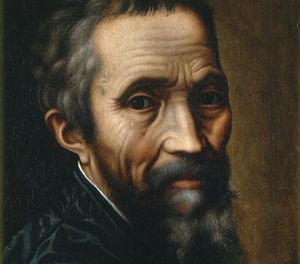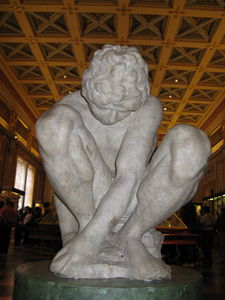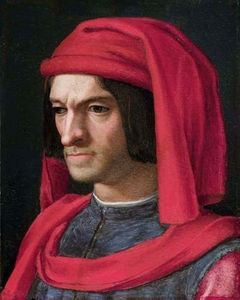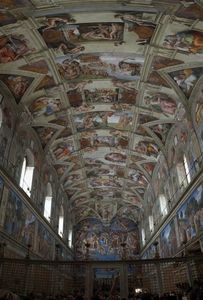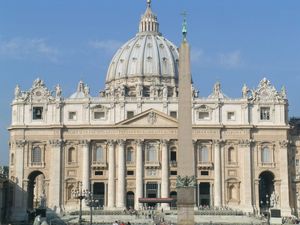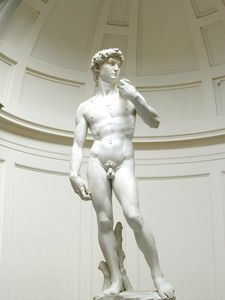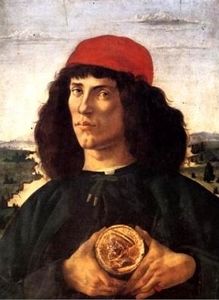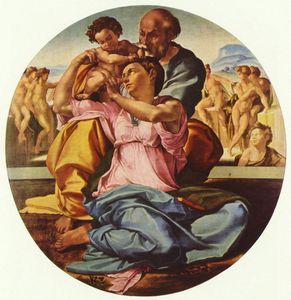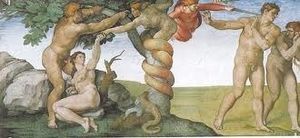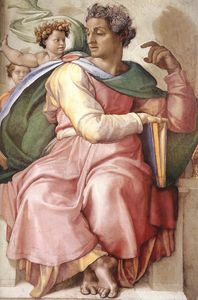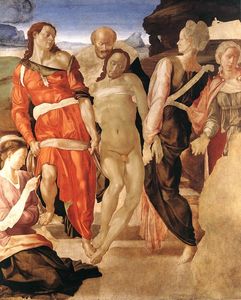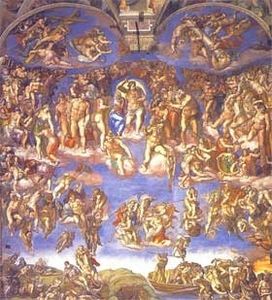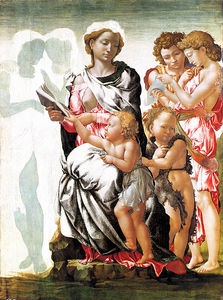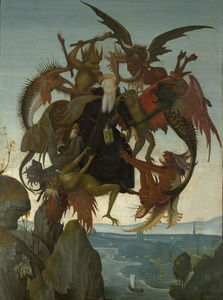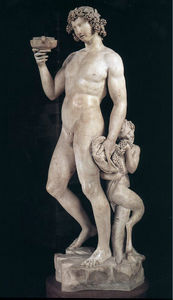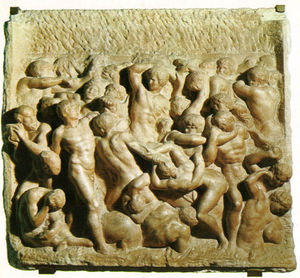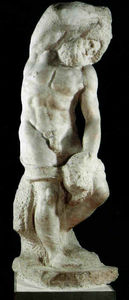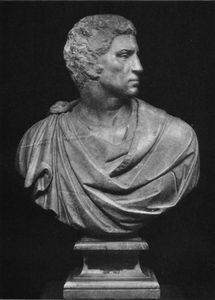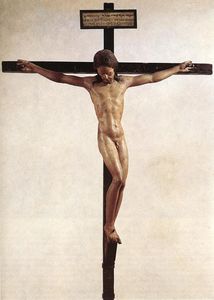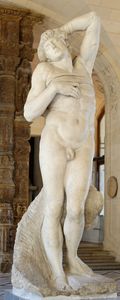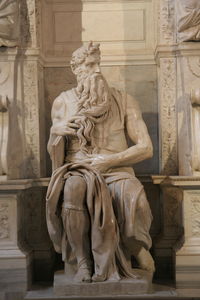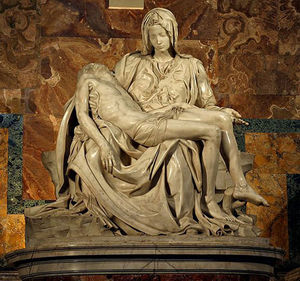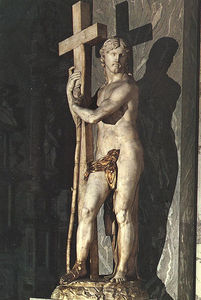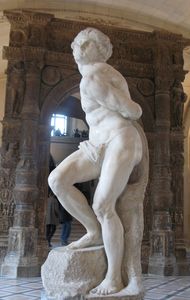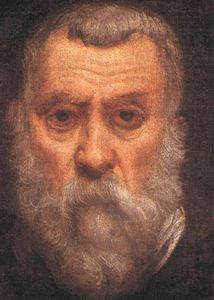Michelangelo
- Full Name:
- Michelangelo di Lodovico Buonarroti Simoni
- Date of Birth:
- 06 Mar 1475
- Date of Death:
- 18 Feb 1564
- Focus:
- Paintings, Sculpture, Architecture, Drawings
- Mediums:
- Oil, Wood, Stone, Other
- Subjects:
- Figure, Fantasy
- Art Movement:
- Renaissance
- Hometown:
- Unknown City of Tuscany, Italy
- Living In:
- Florence, Italy
- Architecture:
- Saint Peter's Basilica
- Michelangelo Page's Content
- Introduction
- Biography
- Style and Technique
- Who or What Influenced
- Works
- Followers
- Critical Reception
- Bibliography
Introduction
Michelangelo was born in Caprese, Italy, to a family who believed themselves descended from Italian royalty. His mother died when he was at a young age and although his father was not wealthy he held high expectations for Michelangelo's future. Therefore, his father was unhappy when the young Michelangelo took an interest in sculpture and went to live at the Florentine court.
Nevertheless Michelangelo was highly successful throughout his career. Moving between Rome and Florence he undertook many architectural, painting and sculptural projects. He was a multi-talented Renaissance man and his work has gone down in history as some of the greatest ever produced.
Although he failed to complete any of his architectural ventures from beginning to end what Michelangelo did achieve was highly praised. The critical reception of his work has always been excellent and today hundreds of people flock to Italy each year to behold his achievements.
Michelangelo Biography
Michelangelo di Lodovico Buonarroti Simoni, known simply as Michelangelo, was born in Caprese, Italy, in 1475. His father held a position in the local government and when Michelangelo was only a baby the family moved to Florence. Michelangelo's wet nurse was the wife of a stonemason and Michelangelo always credited his sculptural skills to drinking her milk.
When Michelangelo was only fifteen he went to live at the de Medici court in Florence at the request of Lorenzo the Great, the ruler of Florence. He spent the next few years of his life living between his family home and the court, learning from some of the greatest artists of his time. However, in 1494 the ruling family was run out of Florence and Michelangelo relocated to Bologna.
Nevertheless it was not long before Michelangelo was back working in Florence and there he produced the False Eros, which was sold to a cardinal in Rome as an antique at a highly inflated price. Although the antique Eros was discovered to be modern it was admired by all for its beauty and it shot Michelangelo to fame.
Michelangelo relocated to Rome and became such a favorite of the Pope that he was eventually asked to paint the frescoes on the ceiling of the Sistine Chapel. Although originally skeptical about taking on this project, thinking that others were trying to sabotage him, Michelangelo eventually did to great critical acclaim.
The artist spent the next years of his life moving between Florence and Rome, until eventually he left Florence for good. He created many great artworks during this period. Michelangelo's last commission was to continue the work on St. Peters Basilica in Vatican City, Italy. Although it was not finished before he died his work on the dome cannot be underestimated.
Michelangelo Style and Technique
Although Michelangelo worked within the spheres of architecture, painting and sculpture he primarily considered himself a sculptor. Nevertheless, he learned the art of painting frescoes when he was young and working as an apprentice in Ghirlandaio's studio. Throughout his career Michelangelo said that he preferred to paint frescoes than work with oil paints.
When he was asked to paint the ceiling of the Sistine Chapel he attempted to turn the commission down. Michelangelo was convinced that other artists were attempting to sabotage him by convincing the Pope to commission him for a painting project when he was primarily a sculptor. Obviously this was not the case and he painted the frescoes which proved hugely successful.
Michelangelo used brash, braying colors that harmonized most painters' expectations. On the ceiling of the Sistine Chapel he demonstrated his ability to create large, beautiful pieces. Furthermore, he was a devotee of mixing Greek and Roman mythology with traditional Christian scenes.
With his sculptures, such as David, Michelangelo understood how light and shadow worked together to create form, volume and shape.
Michelangelo worked primarily with the human form and believed that all beauty could be seen in the human body. Whereas da Vinci believed that human form and nature could synchronize, Michelangelo saw nature as something that man had to overcome. For him the body was the physical embodiment of the soul.
Today there are over 900 sketches by Michelangelo in existence. The artist worked from drawings when creating all of his pieces and they act as a wonderful account of his working method.
Who or What Influenced Michelangelo
Michelangelo was influenced by many artists throughout his career. Although he preferred to tell people that he was self-taught there were those along the way who helped to shape his skills. For example, at a young age Michelangelo worked under the great Florentine sculptor Domenico Ghirlandaio, who helped to form Michelangelo's opinions about art, and taught him different drawing methods.
Yet, Michelangelo soon moved on from this early apprenticeship and the influence Ghirlandaio had on the young artist cannot have been great considering the short period of time they spent together.
Subsequently Michelangelo's next works were produced at the Florentine court under the ruler Lorenzo the Great. It was during this period that Michelangelo spent time alongside some of the greatest artists in Florence.
Working under the sculptor Bertoldo di Giovanni he learned a great deal. Giovanni himself had once been an assistant to Donatello and was a highly respected artist in Italy during this period.
Other artists who inspired Michelangelo include Lorenzo Ghiberti, a Florentine artist from the early 1400s. Ghiberti designed the metal doors for the Cathedral in Florence which showed scenes from the Old Testament. Michelangelo was familiar with Ghiberti's work, having been bought up in Florence himself. Although Ghiberti died before Michelangelo was born it is said that the Adam Michelangelo painted on the ceiling of the Sistine Chapel was based upon Ghiberti's Adam and Eve.
Michelangelo Works
Michelangelo Followers
There were many artists that followed Michelangelo and were influenced by his works but he had greatest impact on the Mannerists. During his later years Michelangelo's work began to subtly change. His figures became elongated and he began to move away from the High Renaissance's style of painting. He was always a proponent of separating man from nature, a trait that the Mannerists embraced, and many have called him one of the original Mannerists.
The Mannerists were influenced by art rather than nature. They looked to the figures in the earlier paintings of the Renaissance for inspiration but rejected the Classical style of art. The art critic Friedlaender gave a definition of what he believed a Mannerist art work had to entail; according to him such art has half-clothed figures that are not exact representations of man. Rather there are formless shapes that bend around each other and spill out of the painting. Additionally, he said that Mannerist art used harsh, braying colors and rejected the traditional laws of perception.
Although Michelangelo was not a member of the Mannerist movement they followed on from the work that he had began. For example many see The Last Judgment as one of the earliest Mannerist works.
One of Michelangelo's biggest followers was the painter Tintoretto who resided in Venice. Like Michelangelo Tintoretto created mainly religious themed pieces. He worked primarily for religious fraternities - groups that decorated their club houses with grand pieces. Though, unlike Michelangelo, Tintoretto's early works did not marry Christian art and Pagan imagery. His pieces wholly connected the gap between the spiritual and ordinary, taking away the didvide between the natural and the supernatural.
Michelangelo Critical Reception
Michelangelo is one of the most revered artists of all time. A sculptor, painter and architect he was a highly talented man who was gifted in many fields. At a young age his efforts were admired by the ruler of Florence, Lorenzo the Great, and from that time onward the critical reception of his work was impressive.
During life:
The critical reception of Michelangelo's work was great from an early stage. His early drawings and sculptures were highly indicative of the designs that he would later produce. Living at court with the ruling family of Florence his work was exposed to some of the greatest artists of his time who all admired his unique talent.
In his twenties the Eros that Michelangelo created as a false antique greatly angered the Cardinal who bought it. Nevertheless it secured Michelangelo's fame in Rome and after seeing this piece many of the ruling class commissioned him to do works for them, until the Pope himself asked Michelangelo to work in Vatican City.
After his sculpture David was produced the city of Florence was so impressed by it that they held a vote on where to place it.
After death:
After his death the critical reception of Michelangelo's work was just as impressive as it was during life. Even so it is hard to measure this due to the sheer volume of it.
Michelangelo Bibliography
For further insight into Michelangelo and his works, please refer to the following recommended sources.
• Amendola, Aurelio & Paolucci, Antonio. Michelangelo's David. Royal Academy: London, 2006
• Falletti, Franca. Michelangelo's David: A Masterpiece Restored. Giunti Editore, 2004
• Graham-Dixon, Andrew. Michelangelo and the Sistine Chapel. Skyhorse Publishing, 1999
• Hartt, Frederick & Wilkins, David. History of Italian Renaissance Art. Laurence King Publishing, 2007
• Mancinelli, Fabrizio. The Sistine Chapel. Edizioni Musei Vaticani, 1995
• Pittaluga, Mary. The Sistine Chapel. University of California, 1965
• Wallace, William. Michelangelo: Selected Scholarship in English. Washington University, 1995
• Hirst, Michael, et al. The Sistine Chapel: a glorious restoration. Abrams, 1999
